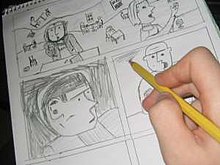In comics studies, sequential art is a term proposed by comics artist Will Eisner[1] to describe art forms that use images deployed in a specific order for the purpose of graphic storytelling[2] (i.e., narration of graphic stories)[3] or conveying information.[2] The best-known example of sequential art is comics.[4]

Etymology
editThe term "sequential art" was coined in 1985 by comics artist Will Eisner in his book Comics and Sequential Art.[1] Eisner analyzed this form into four elements: design, drawing, caricature, and writing.[1]
Scott McCloud, another comics artist, elaborated the explanation further, in his books Understanding Comics (1993) and Reinventing Comics (2000). In Understanding Comics, he notes that the movie roll, before it is being projected, arguably could be seen as a very slow comic.[5]
Related terms include: visual narrative,[6] graphic narrative,[7] pictorial narrative,[8] picto-narrative,[9] sequential narrative,[10] sequential pictorial narrative,[11] sequential storytelling,[12][13] graphic fiction,[14] graphic literature,[15][12][16][17] pictorial literature,[18] sequential literature,[19] and narrative illustration.[20] The related term sequential sculpture has also been used.[21]
See also
editReferences
edit- ^ a b c Will Eisner, Comics and Sequential Art, Poorhouse Press, 1990 (1st ed.: 1985), p. 5.
- ^ a b Will Eisner, Graphic Storytelling and Visual Narrative, W. W. Norton, 2008 (1st. ed.: Poorhouse Press, 1996), "Introduction: Comics as a Medium."
- ^ The term "graphic stories" is variously used as a synonym for either works of graphic literature (cf. Robert C. Harvey, The Art of the Comic Book: An Aesthetic History, University Press of Mississippi, 1996, p. 109; Robert G. Weiner (ed.), Graphic Novels and Comics in Libraries and Archives: Essays on Readers, Research, History and Cataloging, McFarland, 2010, p. 177) or graphic novels (cf. Robert S. Petersen, Comics, Manga, and Graphic Novels: A History of Graphic Narratives, ABC-CLIO, 2011, p. 222); here the former meaning is intended.
- ^ Scott McCloud, Understanding Comics, Harper Perennial, 1993, p. 5.
- ^ "You might say that before it's projected, film is just a very very very very slow comic!"—Scott McCloud as quoted in Michael Cadden, Telling Children's Stories: Narrative Theory and Children's Literature, University of Nebraska Press, 2010, p. 149.
- ^ Will Eisner, Comics and Sequential Art, Poorhouse Press, 1990, p. 26.
- ^ Lan Dong (ed.), Teaching Comics and Graphic Narratives: Essays on Theory, Strategy and Practice, McFarland, 2012, p. v.
- ^ Neil Cohn (ed.), The Visual Narrative Reader, Bloomsbury, 2016, p. 26.
- ^ Chris Mautner, "An Interview with Jessica Abel and Matt Madden", The Comics Journal, July 26, 2012.
- ^ Hannah Miodrag, Comics and Language: Reimagining Critical Discourse on the Form, University Press of Mississippi, 2013, p. 143.
- ^ Aaron Meskin and Roy T. Cook (eds.), The Art of Comics: A Philosophical Approach, Wiley-Blackwell, 2012, p. xxx.
- ^ a b Carole Ann Moleti, "Graphic Literature: A Blend of Genre, Medium, and Form: An International Survey of Graphic Literature", The Internet Review of Science Fiction, June 2008.
- ^ Durwin S. Talon, Panel Discussions: Design in Sequential Art Storytelling, TwoMorrows Publishing, 2007, p. 102.
- ^ Ivan Brunetti, An Anthology of Graphic Fiction, Cartoons, & True Stories, Vol. 1, Yale University Press, 2006.
- ^ A term first coined in Italian by Hugo Pratt as letteratura disegnata (see Gianni Brunoro, Corto come un romanzo nuovo. Illazioni su Corto Maltese ultimo eroe romantico, 2nd ed., Milan: Lizard, 2008, p. 225).
- ^ Andrew D. Arnold, "A Graphic Literature Library", Time, Nov. 21, 2003.
- ^ J. J. Llorence, "Exploring Graphic Literature as a Genre and its Place in Academic Curricula", McNair Scholars Journal 15(1), 2011.
- ^ Paul Young, Frank Miller's Daredevil and the Ends of Heroism, Rutgers University Press, 2016, p. 253 n. 7.
- ^ Keith Dallas, American Comic Book Chronicles: The 1980s, TwoMorrows Publishing, 2013, p. 117.
- ^ Shane McCausland and Yin Hwang (eds.), On Telling Images of China: Essays in Narrative Painting and Visual Culture, Hong Kong University Press, 2013, p. 23 n. 12.
- ^ Cf. Elaine H. Kim and Chungmoo Choi (eds.), Dangerous Women: Gender and Korean Nationalism, Routledge, 2012, p. 6: "[Yong Soon] Min's ... visual essay, "Mother Load," features the bojagi wrapping cloth... The first two parts of this sequential sculpture refer to the past and present of ... Korea."